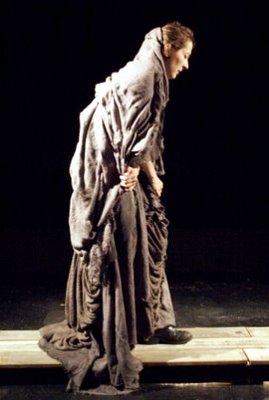Reviewed by Aaron Riccio
In spite of director John Doyle (and thanks to Raúl Esparza), Stephen Sondheim’s musical of vignettes, Company, has made a triumphant return to Broadway. From the set to the lighting, the show has everything going for it except Doyle's gimmick of doubling actors as musicians. Whereas Sweeny Todd forced Doyle to come up with creative combinations of character and instrument, Company rarely uses its entire cast at once, which renders the effect more an economic sidebar than a relevant or fresh medley.

There are a few exceptions--the alto saxophones of "You Could Drive a Person Crazy" flutter about almost as much as Bobby's three flustered girlfriends and "Side by Side by Side" has the five married couples riffing off the beat while leaving Bobby to perform a lonely kazoo solo--but it only makes the trick seem all the more forced. "One's impossible, two is dreary," go the lyrics, "three is company, safe and cheery." That said, why set Elizabeth Stanley with a tuba, only to not let her use it in "Barcelona." Not that "Barcelona" can be sung and played by the same two people--that's a feat no more possible than having the fabulous Heather Laws play a flute while singing the ferocious patter song "Getting Married Today." But then why have instruments at all? Why make it hard for the audience to tell if it's a concert performance or theatrical event that they're watching?
But beyond that first step--and it may be a doozy--Company is a triumph, and Esparza is due a Tony for his commanding work as Robert, top dog of the glowing thirteen person ensemble one moment, depressed romantic the next. Esparza nails every note of Bobby's transformation, from his reefer-rific scene with Jenny and David to his impromptu attempt to marry Amy (on her wedding day) to his relationship with ditzy stewardess April (who he affectionately calls June) and to his final straw with the great cynic, Joanne. More than a series of scenes about socialites in the city and their happily married (or divorced) lives, Company becomes a hopeful yet terrifying look at "Being Alive," which is now every bit the melancholy showstopper it deserves to be.
The place looks great, too: David Gallo's postmodern lounge of a set wraps clear glass stands around a distinctly classic Greek column, and the whole thing is topped with a seven-by-seven diamond of lights. For all its transparency, it makes for a perfect prison, and Bobby, who is constantly standing atop one piece of furniture or another looks as if he's trying to escape the mob of well-dressed but "crazy married people" beneath him. The set remains sleek and bachelor-like even as Bobby starts to drop his facade, and the upper-crust conceit is further deconstructed by Thomas C. Hase's lighting, which rises to the mood of Barbara Walsh's brilliant rendition of "The Ladies Who Lunch" and dumbs things down for the ghost-like interludes from the chorus, like "Sorry-Grateful" and "Have I Got a Girl For You." The piano is the only thing mucking up the feng shui of the set -- unless cabaret was the desired effect for songs like "Another Hundred People."
Company is the quintessential New York play, dripping with love (of our sarcastic, Sondheim kind, flayed and beating on the table in depressingly magnificent glory) from Fourteenth to the Upper West, and the gimmicks can't bring that down. There's too much truth, bravely exposed by this ensemble, for the show to be reduced to anything less than brilliance.



